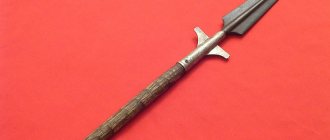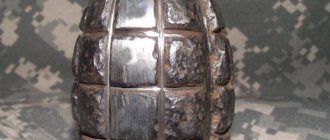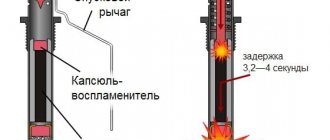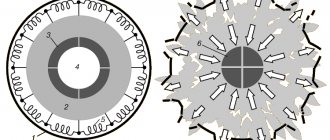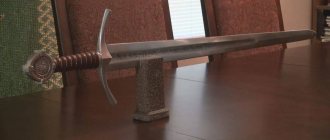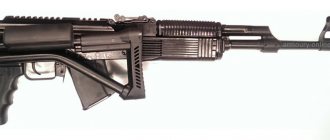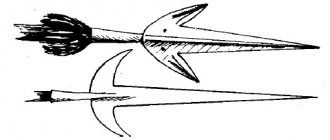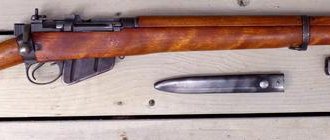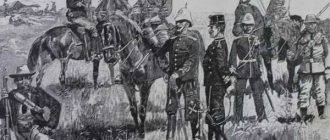The very first knives in history were created by the ancients to cut up the carcasses of killed animals. But the man quickly realized that knives do an excellent job not only with carcasses, but also with ordinary people. This is how swords, blades and other killing weapons were born.
The Romans immediately realized that thrusting did more damage than cutting, but with the advent of armor, thrusting gave way to cutting and only regained its position with the advent of the Renaissance. The main weapon among piercing weapons was the rapier. Its piercing part, in contact with the body, usually caused deep and fatal wounds. The rapier could even pierce through an opponent.
Origins of the "sword to wear with clothing"
This blade originated as a derivative of the sword - a standard piercing weapon, and became a weapon of self-defense among the inhabitants of the late Middle Ages and early Renaissance. It appeared for the first time in Spain, becoming a richly decorated ceremonial weapon. Subsequently, the courtiers learned that the ceremonial combat skewer copes well in a real battle.
Until the 18th century, the rapier reigned supreme among its cold cousins. It was replaced by shortened versions of swords and sabers.
It is noteworthy that in many European languages the word "rapier" means sword.
The explanation is very simple: the Spanish “espadasroperos”, translated as “blade to be worn with clothing”, turned into the French “rapier”, from where it spread to the rest of the mainland.
But in Russia, this word meant a purely training blade, which was wrapped in rags so that it could not hurt a person, and instead of an edge it had a so-called “button.”
Origin of the name rapier
There are a variety of theories about the origin of this name. At first, in the 16th century, French fencers called any long and thin weapon rapiére. While the Spanish warriors called the small blades carried by civilians spada ropera, which means “clothing sword.” In the next century, the British called similar weapons rapiers, and in the Germans - Rappier and Rapir. Over time, the word “rapier” began to be used to describe thin piercing blades.
It is not known for certain how espada ropera or la rapiére differ. Nothing is known about their sizes. But it is known that the Italian nobility of 1480–1490 had blades that were longer and heavier than daggers, but lighter than combat swords. These blades had complex wicker or completely closed hilts. It is possible that over time they became longer, and this is how rapiers appeared.
The war hammer is a very heavy weapon.
Thor's Hammer.
A still from the film “The Avengers” If, when you hear the phrase “war hammer”, you imagine a sledgehammer or Mjolnir of Thor from “The Avengers”, be prepared to be disappointed. The real war hammer had a longer handle (1–2 m) and a small head and Arms & Armor Custom Bec de Corbin weighed up to 1.7 kg.
Do you think this is not enough? Try swinging a modern 15kg sledgehammer from side to side and see how far you can go.
And doing this in the heat of battle is a completely futile idea. Compare the weapon of the Marvel God of Thunder with the historical prototype War Hammer.
War hammer of a healthy man, 15th century. Image: Metropolitan Museum of Art
And in general, the heaviness of medieval weapons is a myth. The Archeology of Weapons: Arms and Armor from Prehistory to the Age of Chivalry. It was much lighter than is commonly believed, otherwise it would have been awkward to use.
Material and manufacturing technique
The rapier is divided into several parts: the hilt and the blade. The hilt, also known as the “handle” of the rapier, is the most elegant part of the weapon. Consists of a guard, pommel and handle.
The guard (as the name suggests) protects the hand from impact. The most elegant part, which was made ornate or patterned. Most rapiers had a closed type, although there are other examples. The pommel creates the necessary balance point 5-10 cm from the guard.
Noteworthy: on some blades the counterweight has a cone-shaped shape.
This form is designed for a side strike in close combat, if the fencer has enough resourcefulness for this (but in real close combat, fencers used a daga - a dagger for the second hand).
The handle, like most representatives of bladed weapons, has a corrugated surface to prevent excessive slipping of the hand. It has a length of about 10-15 cm. The blade, in turn, is also divided into three parts: the strong part, the weak part, and the tip.
The strong part, also known as the dol, had a small recess, had no sharpening and was no more than 1/3 of the size of the blade. Most of the blows were taken precisely on this part. At least the dola did not fall apart under a strong impact.
The weak part, unlike the strong one, had a sharpening, often double-edged.
She could make slashes and cuts, but she still had to be careful with force so as not to break the weapon. As a rule, the center of the impact was located right here, 10-20 cm from the tip. The center of impact is the part of the blade that first comes into contact with the target.
The tip is the part of the blade with which injections are made, a continuation of the weak part, and therefore has a sharpening. It often breaks under a strong blow, but can pierce a person through and through. At least, gunsmiths did not advise delivering powerful blows with the tip, in order to avoid breaking the weapon.
The formulation of tactical and technical characteristics for edged weapons of the 15th-16th centuries is difficult to apply; the general parameters of the rapier are given in the table.
| Material | Iron, steel |
| Length | No more than 1300 mm |
| Diameter | From 30 mm at the edge to 15 mm at the sharpening point |
| Weight | Approximately 1.5 kg |
| Convenience | Above average |
| Wear resistance | Average |
Making a sword or even a good knife is a whole science. It is necessary to maintain the correct proportions of coal and iron when making steel, otherwise the weapon will become unnecessarily brittle. The rapier, like other blades, was made by layering metal.
The first layer is a core of iron to give shape and rigidity. The second layer is steel to enhance elasticity. Iron or steel swords, swords, and sabers were not made separately.
Iron has the property of bending, and carbon steel has the property of breaking when subjected to a strong impact.
It would be unpleasant if a brand new sparkling steel blade breaks or bends at the first blow... But the use of both steel and iron gives excellent results.
The most terrible dagger is the one that moves apart in the pierced body
This dagger, made around 1585, was given to the Elector of Saxony, Christian I, by Vincenzo I Gonzaga, Duke of Mantua.
Image: National Renaissance Museum, Écouen, France / Bokken / Wikimedia Commons It is quite possible that you have seen photographs of such blades on the Internet. This is a rare German or French variation of the Spanish dagger-dagi - man-gauche (French main gauche, “left hand”). It was invented in the 16th century.
Some believe that the purpose of such a dagger is to open in a wound. This way it will not be possible to reach it, and it will remain in the enemy’s body.
However, this is complete nonsense. Sticking a weapon into an enemy and leaving it there is stupid: firstly, you will be left without a dagger, and secondly, this will only help your opponent not bleed longer, since the blade will plug the wound. And the men-gosh could not open up inside the body.
The dagger could have a spring that opens additional blades, turning it into a kind of trident. Or additional blades were removed manually. But this was done in order to catch the enemy’s sword, because the main purpose of the dagger is to parry European Weapons and Armour: From the Renaissance to the Industrial Revolution, Daggers and Fighting Knives of the Western World: From the Stone Age Till 1900, Spotlight: Combination Weapons blows. And yes, she could not close, grasping the blade - after the fight she had to fold it with her hands.
Strength of rapiers
There is historical evidence that rapiers could break during battle. They broke against bodies or from hitting each other. The rapier blade was very thin and light, which affected its strength. As a result, it broke upon contact with any hard object. It is known that gunsmiths recommended not to strike with the tip, or at least not to hit it very hard.
Although rapier blades are fragile, they are not that vulnerable. Rapiers can be quite strong and can parry thrusts from heavier weapons. but only with the middle, more durable parts of the blades, hilts, or with the help of attacks that divert blows, without placing hard blocks. The best option was to dodge the blow rather than deflect it.
Bloodstock helps deal more damage
Replica of an early Middle Ages sword with a fuller.
Image: Flickr See the indentation on the blade? This groove is sometimes called the bloodstream. Those who call it that believe that it allows more dangerous wounds to be inflicted on the victim. You plunge the sword into the enemy, blood gushes through the indentation, and the enemy dies.
Apparently, while the blood flows through the bloodstream, the fighter must stand next to the pierced enemy and wait for him to finally give his soul to God.
In fact, this groove does not increase blood loss in any way. It is enough to simply pull out the sword so that it stops plugging the wound, and the victim bleeds to death. No blood flow is needed.
The real purpose of the "Blood groove", AG Russell knife encyclopedia groove is to lighten the weight of the blade and increase its strength. Therefore, it is correct to call it not blood flow, but dol. This is a special hollow with stiffening ribs.
Why were rapiers created?
Rapiers evolved from earlier cutting-and-stabbing swords and were a weapon of self-defense in the city, as well as in frequent duels. For this purpose, master gunsmiths made fast, mobile, one-handed piercing weapons. They could be used on streets, alleys or places with limited space. There was close interaction between swordsmen and weapons masters.
All new inventions were tested in practice. And the most successful elements were retained and improved taking into account the requests of those who used them. Initially, rapiers were created as something of a kind of response to cutting and piercing swords, and later they began to be used as a counter to other rapiers.
Over time, new types of weapons were invented along with the technology for their use. At the beginning of the 16th century, people could not go out on the street with huge battle swords. Then lighter, thinner and less huge weapons began to appear. However, the appearance of thin and light blades for everyday duels continued to change throughout the century. They acquired their final forms only towards the end of the 16th century.
When were they used?
Weapons resembling rapiers appeared by the middle of the 16th century, but the name itself appeared earlier. Forms more similar to the current ones appeared later, and then continued to be modified until the end of the 17th century. The Spaniards used rapiers even in the 19th century. In certain European regions in the 18th-19th centuries, ancient rapiers were sometimes used in so-called “formal” fights. In addition, other hilts were often attached to old blades, and sometimes they were shortened.
There is a well-known legend that master swordsmen had a hand in the invention of piercing swords in the 16th century to replace “heavy cutting swords.” This is not entirely true, because sharpened piercing swords (heavy and light) have existed in huge quantities since the 14th century. In addition, despite the almost two hundred years of use of “heavy chopping swords,” they were still widely used, but in a slightly modified form (such as sabers, broadswords, etc.). Moreover, even after rapiers ceased to be popular.
The influence of rapiers on fencing technique
Essentially, rapier fencing was about the shortest distance between a pair of points being a straight line of thrust. The speed and reach of rapiers in battle could be a surprise for warriors who did not know this style of fighting. In the hands of a master, rapiers were unpredictable, swift, and inexperienced opponents could simply underestimate them.
Stabbing wounds were easily inflicted and were often fatal. If someone tried to deliver slashing or cutting blows with the help of a less agile slashing weapon, then he quickly received a thrust from a rapier, which was more maneuverable.
During linear attacks, fighters, as a rule, tried to synchronously defend and counterattack with scrupulously calibrated movements, avoiding the opponent’s thrust in advance. This could be done with one movement. At the same time, the connection with the enemy’s blade was preserved.
In addition, this was done with a free hand or an additional weapon. The long, thin blades were perfect for these actions. However, sometimes the large length could interfere, and all because the enemy with a short weapon could, technically bypassing a rapier strike, use a stiletto.
Thin, unpredictable rapiers were an everyday weapon, mainly for resolving conflict situations. They were created for street fighting, and were the main civilian weapon of self-defense. From simple practical objects, they became popular attributes in the “noble art.”
And a decent glaive also has two blades
By the way, one more thing for fans of Nik Perumov’s work. The main character of his books, Fess, brandishes a weapon that he calls a glaive - a stick with wide blades at both ends. At the same time, he demonstrates incredible skills in filigree fencing with this contraption, exterminating extras on an industrial scale.
So, the glaive is not like that. Here she is
.
Glaive of Augustus I of Saxony (reigned 1553–1586). Image: The Metropolitan Museum of Art
The length of the shaft of European Weapons and Armor: From the Renaissance to the Industrial Revolution was approximately 1.5 m, the blade reached 60 cm in length. The glaive was intended mainly for fighting cavalry and weighed under 4 kg. This is a funny figure if we are talking about dumbbells, but quite serious if we are talking about weapons: you won’t be able to twirl them gracefully in battle.
But the glaive could kill or cripple a horse on which a knight swinging a sword sits. Well, or pull it off the saddle with a sharp hook or a spike on the butt.
Of the real weapons, Holmes Welch, The Practice of Chinese Buddhism “monk’s shovel”, or “Zen staff”, which was carried by Shaolin monks, is more or less similar to the Fess glaive. But this is not a weapon, but really a shovel - it was used to bury the dead according to Buddhist customs, and sometimes to drive away stray dogs and hooligans. The metal parts were not even sharpened.
Sports fencing
The rapier gave impetus to the development of a whole trend in the art of wielding military weapons. Mastery of bladed weapons has ceased to be the prerogative of the military. The design and shape of the blade led to the emergence of its own fencing technique, based on special techniques. The massive spread of the sword led to the emergence of fencing schools throughout Europe. It should be noted that each fencing school had its own distinctive features associated with national color and the specifics of social life. Already in the middle of the 17th century, the first textbooks on the art of using a rapier appeared.
Over time, fencing skills are improved and systematized. Certain standards for the civilian modification of swords are being developed, and accordingly the most convenient and effective techniques for wielding piercing weapons appear. It is worth noting, for example, that in the German and Spanish schools, chopping techniques dominate in fencing techniques, which later formed the basis for the art of saber fencing.
A rapier thrust, i.e. defeating the enemy directly with the tip of the blade was common in the Italian and French fencing schools. The grace with which opponents met in confrontation became a trademark of the Italian style. The result was a widespread fascination with the Italian style of fencing. In royal houses and prestigious educational institutions, fencing is introduced as a compulsory academic discipline. A special position becomes prestigious - fencing master, fencing teacher.
The sports rapier appeared at the end of the 19th century, radically different in shape and equipment from the combat and civilian versions. The blade of the weapon received a rectangular cross-section and became more elastic. The rapier thrust has become the main technique, around which a lot of other elements of defense and attack have already appeared. The flexibility of the blade allowed the weapon to maintain its integrity during large bends during a piercing blow. The equipment of the weapon itself has also undergone changes. The guard, instead of its pretentious shape, becomes convex on a sports rapier. Now it is not the beauty of the product that is important, but its protective function. The weapon itself becomes light, weighing no more than 500 g.
The lightness and convenient shape of the rapier allowed even women to take part in fencing competitions, which at the present stage is becoming a purely applied sport. The traditions of military and civilian use of swords, combat techniques and the art of wielding bladed weapons imperceptibly passed into the rules of sports tournaments. At first, ceremonial tournaments of a private nature began to be held, and a little later the competitions became international.
The national fencing championships became the first sign on the way of the foil into the world of big sport. Already at the first Athens Olympics in 1896, the program of the games included a fencing tournament. Initially, the fencing tournament was general and held in one discipline. Four years later, in 1900, at the Olympic Games in Paris, athletes competed in three disciplines. Separate tournaments were held in saber, epee and rapier fencing.
What is the difference between training rapiers and real ones?
Real rapiers are extremely stiff. They were made so that they could easily pierce human bodies in battle. In addition, rapiers were supposed to deflect blows, and blades were not supposed to bend. To avoid this, the rapiers had a special cross-section.
This is the result of fencers' desire to have safe training weapons. It could bend to a certain level without breaking or penetrating into the bodies of opponents. Such flexibility is precisely inherent in sports fencing. Which in turn influences the general opinion about rapiers, and also changes the actual techniques of fencing with them.
In our understanding, a sword and a rapier are about the same thing - a sharp weapon that is probably not easy to master. But, as a linguist, I will tell you that there are not as many absolute synonyms among nouns in the Russian language as it seems. Usually the same thing is not named the same without reason. Different names indicate either that the objects are still different, or that, for example, the original Russian and borrowed names coexist. So, is the difference between a sword and a rapier real or linguistic?
The word “sword” came to us from Romance languages, and “rapier” from Germanic. Consequently, the linguistic difference between them is already obvious. In general, a sword is a type of bladed weapon that evolved from a sword. The rapier as a type of edged weapon, namely a type of sword, arose later, when the need arose to use swords not for military purposes, but for sporting and symbolic ones. The rapier was most common in the 1700s, and the classic sword before that. A regular sword is heavier and longer than a rapier, while a shortened sword is lighter. In addition, the difference between a sword and a rapier is that a sword can be considered a cutting weapon, and a rapier has lost this quality. The guard (that is, the part of the handle directly adjacent to the hand) of the sword is more complex and elaborate, which is technically good for those who are learning to master it.
Cutting a man in half is easy
Just another Japanese custom.
Illustration from the book 平凡社 1927 Image: Public Domain Cutting a victim in half is a fairly popular technique in various films, TV series and games. A quick blow, the victim freezes for a second, and then falls apart. You could see this in works like Underworld, Equilibrium, Kingsman: The Secret Service and many others.
Well, if you are a fan of The Witcher, remember how many times in the games Geralt cut his opponents into two parts.
However, in reality this is an extremely difficult, if not impossible, task.
The Japanese have a martial art called tameshigiri Kapp, Leon. The Craft of the Japanese Sword - cutting through straw sheaves, mattresses, and, in the past, human corpses and convicted criminals with a katana. The Chinese also dabbled in similar things, Li Si.
But the test subjects, on whom the samurai honed their sword skills, were naked and tied up. In addition, the blades were often damaged when chopping bones and required new sharpening. Or they could have fallen into disrepair altogether. And even in ideal conditions - when the victim is naked, tied up and does not move - it was not always possible to cut him open.
In this experiment Can A Sword REALLY Cut You In Half? A professional kendo master tries to cut a ballistic dummy in half. Spoiler: he didn't succeed. Although it’s unlikely that anyone would want to be in the place of the doll, of course.
The sword cuts through tissue well, but it’s not easy for them to cut through bones: it gets stuck in them. So you won’t be able to cut enemies at the waist or completely across, especially if they are dressed and move at least somehow. But blowing off heads or limbs is fine. Although not as easy as in the movie Monty Python and the Holy Grail.
